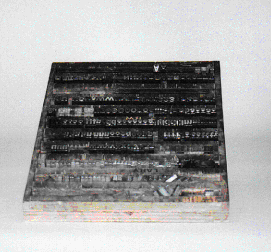
For many years newspapers were the only means by which southern Albertans could find out about what was happening in their community, their country, and the world. Newspapers provided southern Albertans with valuable information about cattle brands, and animal and grain prices, in addition to bringing together opinion on issues which affected them. For example, the call for irrigation and a library were originally voiced in Lethbridge newspapers and once published brought increased interest to the matters.
As early as 1882, the people of Lethbridge had access to a newspaper. Two former N.W.M.P. officers, E.T. Saunders and C. E. D. Wood published the first Macleod Gazette from Fort Macleod. The men ran a hand driven press powered by Native workers. It was Saunders who moved to Lethbridge in 1885 and began the weekly Lethbridge News. The Lethbridge News began to be printed two times a week in 1890 but was forced to become a weekly in 1891. Between 1891 and 1896 the Lethbridge News worked hard to persuade the government to build a Crow's Nest rail line and an irrigation project. Its' work paid off in 1896 when construction began on the Crow's Nest Line.

Type set panel used in the early printing presses.
In 1900, E. Hagell became a partner in the business, and when Saunders sold his part of the company to a local businessmen a few years later Hagell became manager of the News. The News expanded operations again in 1905 and began publishing a daily paper called the Southern Alberta News. The paper was published for about one year before again becoming a weekly. The Weekly News was published until 1910 when it was purchased by the Southams company. Southams published a paper called the Morning News for about a year before closing the operation and moving the plant.
Lethbridge's second newspaper appeared on November 8, 1905, and was called the Lethbridge Herald. Fred E. Simpson, owner of the Cranbrook Times, and his partner A.J. Bennett began publication out of an old Chinese laundry and , since the building was not large enough to have a printing press, all printing was done by the Lethbridge News' printer. The paper was soon bought by W.A. Buchanon an eager young reporter who had recently come to Lethbridge from St. Thomas Ontario. In 1907, Buchanon decided to take a chance and make the Herald a daily evening paper. Buchanon expanded the Herald's operations, moving the paper to its first permanent quarters at 6th Street and 4th avenue south in December of 1909. After several expansions the Herald moved to its current location at 7th street and 5th avenue south in 1951. At the time the new facilities were considered the most modern newspaper plant in western Canada.
Hard times during the depression led the Herald to on of its greatest moments. Several Alberta governments had tried to keep newspapers quiet by using "gag laws". These laws made it difficult for newspapers to print things that the government didn't like. The United Farmers of Alberta government of 1934 made such a law to stop the coverage of a sexual scandal involving Premier J.E. Brownlee. Later, in 1937, the Social Credit party, under William Aberhart, passed the "Act to Ensure the Publication of Accurate News and Information". The Herald fought hard against the law and for its work it won a Pulitzer Prize.

The Herald was responsible for informing town residents of upcoming events and entertainment.
The Herald again gained national and international fame in 1953, this time for a photograph. On February 14, 1953 Mayor A.W. Shackleford was at a beauty contest when he grabbed two separate microphone stands, one in each hand, to speak. The differences in current between the CJOC and public address system microphones caused an electric current to pass through the Mayor that clamped his hands to the stands and sent him jerking backwards. Herald photographer F. Orville Brunelle caught the event on film and the photo became instantly famous. The picture appeared in 1 300 magazines and newspapers all over the world, including the London Daily Mirror. Life Magazine made it the "picture of the week" on March 2, 1953. As well the photo won for Brunelle the Canadian Press " best picture of the year" award for 1953.
Changes in the newspaper industry caused the Lethbridge Herald to be sold to the Thompson newspaper chain in 1980. The change caused trouble when Thompson fired the old editor and replaced him with their own editor in 1982. The cost cutting measures of the new editor made many people in Lethbridge very angry. Some formed the "Committee for Quality Journalism" which arranged demonstrations and boycotts of the paper. Two new weekly papers came from the controversy, but neither managed to last, nor did the controversy as the issue was eventually forgotten.
The Lethbridge Herald continues to publish in the city today. The paper is now owned by the Southam News chain, ironically this is same chain that the Herald forced out of the city back in 1905.
Previous Page | Exhibit Contents | Home | Navigation Information | Glossary | Curriculum Guide | Next Page
Copyright © 1996 Sir Alexander Galt Museum. All rights reserved.